In-depth discussions of identification of North American birds
click on any links below to find more info on that topic or species
Most recent posts on birds
- Distinguishing Hermit Thrush and Gray-cheeked Thrush May 14, 2025
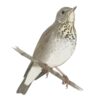
- Distinguishing Philadelphia and Red-eyed Vireos by song: Is it possible? April 26, 2024
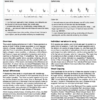
- Determining age and sex of Rose-breasted Grosbeaks in spring and summer April 26, 2024
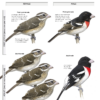
- Two species of Cattle Egrets? October 26, 2023
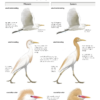
- Identification of the newest meadowlark – Chihuahuan September 19, 2022
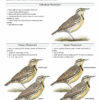
- Subspecies of Common Grackle: Bronzed, Florida, and “Purple” May 4, 2022

- Finding and Identifying Stejneger’s Scoter in Alaska April 13, 2022
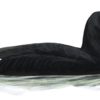
- Identifying small flycatchers: Separating Elaenia and Empidonax by wing pattern April 7, 2022
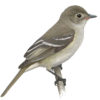
- Why do Jewelweed seed pods explode? October 1, 2021

- Mew Gull is now two species! How to identify Common Gull and Short-billed Gull July 3, 2021
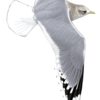
Reference and nomenclature
A list of important online bird references
Changes to official bird names in 2010
Changes to official bird names from 2000 to 2009
The Subspecies concept in the Sibley Guide to Birds
Bird Subspecies names in the Sibley Guide to Birds
Birding Basics and introductory topics
On the psychology of bird identification:
Ambiguity and bird identification
Redpoll investigation widens to include “Greater” – another manifestation of subjective impressions of ambiguous features
Probability in bird identification
On bird songs:
More vocal copying by American Goldfinch, Purple Finch, and Ovenbird
On finding rare birds:
How many rare birds do we miss?
How many rare birds did we miss before the internet?

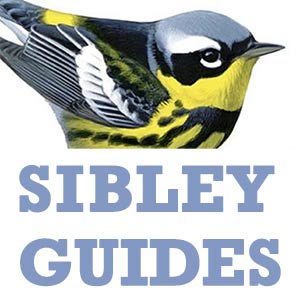
you used to have a great list of subspecies and their scientific names which correlated to the regional designations you gave them in the book. Why did you take it down? I can’t find it on the site anymore.
Hi Travis, When I revamped the site a month or so ago I took down the subspecies list, planning to update a few things and repost. Hopefully I can get that done and back up in the next few days.
Perhaps this question has been asked before. I’m curious why Pink-footed Goose is not included in the Sibley Guide? Perhaps a thought-to-be-wild bird had not occurred in North America as of 2000.
Pink-footed Goose was not included in the Sibley Guide because at the time that I was working on the book (1990s) it was too rare and didn’t meet the threshold for inclusion. It is one of a few species that increased in frequency even as I was working on the guide, and would certainly be included now. Hopefully I can get around to doing a revised edition someday and I would definitely include it in that. Other species are Cahow, Green-breasted Mango, and a few others.
There was a possible Pink-footed Goose spotted here in eastern Kansas a couple days ago, those of us that saw it are thinking a juvenile but there is very little reference material that I can find showing this bird as a juvenile. Do you have a plate worked up that you could share with us?
Hi Brandon, All geese can be aged at least until mid-winter by feather shapes. The differences I described for Canada Geese in a post here https://www.sibleyguides.com/2009/10/ageing-canada-geese/ should work just as well for Pink-footed and other species. By December most young geese have molted some of the upper flanks, so you’ll also see a contrast between broader, darker, more contrasting feathers there alongside the paler/faded, more rounded juvenile feathers on the belly. All that said, I see from one posted photo that the Kansas bird looks more like an immature dark morph Snow Goose – an understandable mistake. Pink-footed should have a dark brown head and neck, warm brown on the breast, etc.
David
I wanted to thank you for all the hard work I know you put into your books and field guides on birds. I recently acquired two of your books and they are the best I have ever seen. It is so helpful to see birds especailly the birds of prey in their different phases and flight patterns.
Billy
Your beautiful guides and descriptions are very welcome additions to the world of birds. Being able to understand the birds in your back yard, your camp site, or on your nature walk, is the key to having a great appreciation of life. Birds bring so much to help people stay connected to the earth!
Did the record of the Green Violet-ear Hummingbird make the range maps in your new book? We had the honor of hosting this wonderful bird at our feeders in our yard. This was in 2003 for 55 days. We turned it in and had the WVDNR and record people out to see the bird. Paul Lehman also came and viewed the bird. We had over 300 people come for the bird. Live in a gated area or we would have opened it up to more people. Of all those people only one birder was a sour birder. He lives in Kingwood WV of all places.All the other birds and clubs were very nice to meet. We even got some neat gifts bird feeder, books, bags sugar,candy. I have lots pictures and hours of video. We enjoyed talking wiht some really special people about birds. Even had two federal bird bander here one day. They were unable to catch him. We keep our eyes out each year for one to return. Thank you
Hi Kim, Thanks for your note. The maps in the books were last revised in 2002 (by Paul Lehman) so your Green Violetear did not make it in time. I’ll add it to the next revision.
I ask you to consider my interpretation of a novel observation (NECO extended gular sac coloration) that I have posted on my website:
http://www.richbyoung.com/text-gular-id.html
When I posted these images, numerous birders emailed me saying they had never seen nor heard anything in the literature regarding the NECO pink coloration and its ramifications.
I discovered NECOs in Northern Utah for the first time in April 2009, http://www.utahbirds.org/RecCom/2010/2010_21Summary.htm , and twice again in 2010, http://www.utahbirds.org/RecCom/2010/2010_23Summary.htm ,
http://www.utahbirds.org/RecCom/2010/2010_20Summary.htm
I found a stable population of 7 NECOs in the Salt Lake Valley at a permanent site that I studied over a 4 month period (May 2 through Oct. 18, 2010).
Being retired, I spent over 200 hours studying these birds, with my main emphasis being photo-documentation.
Among other things, I was struck by the unique ‘social signaling’ done by the NECOs available to me; specifically when I observed the pink coloration of their gular sacs when extended.
Early on I noted there were major differences between NECO/DCCO extended gular sacs.
Taking this a bit further, I saw the possibility that, using examples of birds’ (NECO/DCCO) gular sac coloration and morphology, I might have stumbled on a feature that could help clarify the I.D. issue among DCCO/NECO juveniles.
I also believe that, the unique NECO extended gular sac coloration and morphology have been overlooked in the literature thus far.
Any consideration of the above would be sincerely appreciated.
Regards
Richard B. Young
richbyoung.com
Hi Richard. Thanks very much for posting all this. I was not aware of any color difference but it looks like you have documented it pretty thoroughly.
I was hoping to find someoe to help me identify a bird we had show up on our deck this morning, I took a picture and was hoping I coupld post it in here in hopes of someone telliing me what typee of bird it is. Is there a place in here to post pictures?
If you click the “contact” link above you can attach a photo there and I will be happy to take a look and identify the bird
Hi ! David
When will you updated your APP EGUIDE to the Birds of North America
whit new name (Dendroica becoming Setophaga, etc…)
And gradulations for you for this APP about this birds. Bravo! to you!
It a practical way to identify birds on the field.
Thank you very much for this APP. Peter Lane from Québec City, Canada
Thanks Peter, We’re working on an update now, and at this point it makes sense to wait until the 2012 AOU list update is published so we can add those changes as well. Best, David
I thought that you would find this a bit interesting. In the southern US the range of the Bronzed Cowbird and the Brown-headed Cowbird overlap. One of their hosts, the Abert’s Towhee, has a nest in my backyard. Both birds parasitized the nest. Abert’s Towhee clutch size is typically 2-4 eggs. This nest has 6 eggs in it, 3 Bronzed Cowbird eggs (1 damaged by what looks like a bird peck), 2 host eggs, and 1 Brown-headed Cowbird egg.
The last picture in this thread shows the nest.
http://www.whatbird.com/forum/index.php?/topic/3844-aberts-towhee/
Wow, that Abert’s Towhee will certainly be the frazzled parent over the next few weeks. I wonder how many cowbirds one towhee is capable of feeding?
Hi David,
I’ve been trying to be able to ID juvenile sparrows (Lincoln’s vs Swamp vs Song). Any suggestions as to were to look?
I am confused about crown color of Swainson’s Warbler. I have your First Ed. (Oct 2000) which describes the crown as “rufous tinged.” The illustration is a rather conspicuous rufous. My National Geographic (3d Ed) describes it as “brown.” Curson, Quinn, and Beadle say, “warm brown.” I have seen only one, but it was very close and in pretty good light. The crown looked distinctly brown, with no suggestion of rufous. I do not have access to study skins. I know you had some problems with color control in the first printing, but I am not aware of any corrections for this species. Would you confirm the true color, please.
Ed Case
Hi Ed, This is an interesting question, and the key concept is what might be called “relative color”. I would say that the crown on Swainson’s Warbler is distinctly more rufous than the rest of the upperparts, and whether you perceive that as rufous or simply as a warm brown depends on lighting and your own personal criteria for when something is red enough to be rufous. No matter what you call the color it is clearly more reddish than the back. I did have a tendency to exaggerate rufous colors in the paintings for the guide, trying to make the difference in relative color obvious, and then the printing process emphasized the red even more. I did not make any changes to the painting for the upcoming revised edition, but I think the new printing will tone it down a little from the first edition.
Best, David
I would like a north american life list of birds that is separate from your excellent book. May I purchase?
I have had a bird feeder and bath in my backyard for about ten years. This past summer, I’ve seen one bird that I can’t identify. At first I thought it was a cardinal, as we have a nice family around here, consisting of Mr., Mrs., one master and two ladies. But this bird is a bit different. It is almost entirely red, but not quite red–almost an orang-red–and has a black head with no crest. It’s beak of orange. It shows up sporadically, and has usually managed to fly away by the time I can grad my camera. But today is was hanging around in my yard for quite some time, so I got a few shots, albeit from a distance. After watching it for a bit, it displayed one of the charactertistics of cardinals that I’ve observed: “kissing.” Meaning this bird is passing on a bit of food to lady/Mrs. cardinal. So I believe he’s in the cardinal family. But I can’t find a picture of him anywhere. (And he doesn’t chip.) I can send a photo. But, sorry, I’m not on facebook.
I live not to far from David Sibley. I’m about twenty miles away, in Melrose, MA. Anyone have an idea what bird this is?
Sorry, I really need to have someone check my typos before I submit. I’m my own worst proofreader!!!!
Pingback: Managed WordPress Hosting Pewee Valley – Buy wordpress hosting
Pingback: United States backyard birdcount results | Dear Kitty. Some blog
I have been trying to fine the type of bird that has 3 notes . Ist note is highest then the 2nd and 3rd notes are lower but the same note. The bird is seasonal, but not visible. At least I haven’t been able to find it.
oh right. The bird has been heard in Calgary, Alberta.
The bird has been heard in Calgary, Alberta
I photographed a duck (female) a few days ago in Petaluma, CA. that and posted the photos in Facebook asking for help to identify the duck. There is a mixed opinion whether the duck is a Redhead, a Rind-necked duck, or a hybrid. I am writing to ask if you can review the photos and help identify the duck (I was able to take a couple good photos today, 11-16-2020, and I have posted them on my website at: http://ronstorey.com/MysteryDuck/ – can I trouble you to please review the photos and tell me your opinion of the species.
Thank you,
Ron Storey
Hi Ron, This is a perennial challenge. Females of both species are brownish overall with white eyerings, similar bill patterns, pale around the base of the bill, etc, and they are quite variable. Your bird looks like a Ring-necked Duck to me based on the very dark back contrasting strongly with paler flanks (Redhead would be more uniform in darkness form back to flanks), and the complete white area across the base of the bill (Redhead would have a dark band arcing across to the gape). I suspect the head shape is confusing some people, but female Ring-necked Ducks have a more rounded head shape than males, especially in their first winter, and when actively diving the head feathers are pressed down eliminating the angular rear crown that is characteristic of Ring-necked Duck.
Hello! I have been trying to make a complete life list of EVERY bird species and subspecies that are native (excluding vagrants, casuals, accidentals, exotics, etc.) to the lower 48, Alaska, Canada and even Hawaii! But this has been a rather more tough task than I thought. Birds that especially confuse me are birds that have been expired (American Flamingo, Key West Quail Dove, Thick-billed Parrot, etc.) or used to never be recorded but are now common breeders (Cattle Egret, Green Parakeet, Shiny Cowbird, etc.) or even birds that used to not breed, then breed here in several years and get expired again (White-tailed Eagle in Alaksa and Tamaulipas Crow in Texas). I also don’t know if I include/exclude non breeders (Eurasian Wigeon, Wilson’s Storm Petrel, etc.) so could you please email me a complete list that match for what I am looking for? Thank You
Is the list of species no longer available as it appears to be broken above.
“List of Species
[child_pages list=”true” post_status=”publish”]”
-tom
Hi all. I hope this is allowed, there is now an phone app created by Cornell for bird identification. So far I have found it to be very accurate. The app is named “Merlin” and you can find it in the google play store. It can identify with a photo or by song.
Hi ! Yesterday I bird flew into my window and I recognize it on your poster but I can’t make out its name under its picture. It’s the black/dark colored one with a blue hue on top of its head and back and it had a light gray under belly with a short beak. 🙂